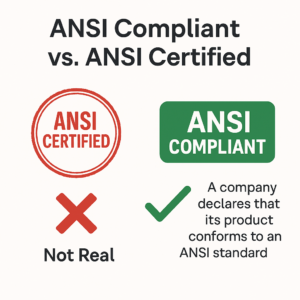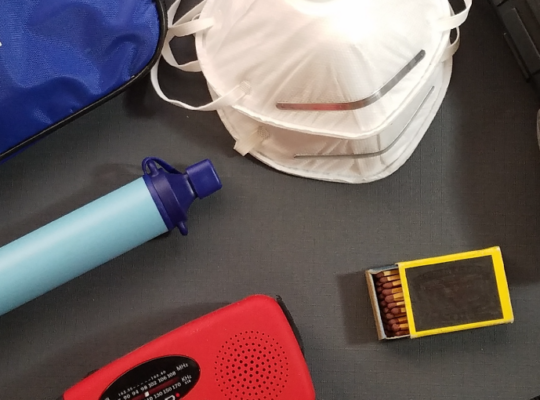When it comes to workplace safety, the first name that often comes up is OSHA. But there’s another organization that plays a vital role in ensuring employees are protected on the job—ANSI, the American National Standards Institute. While OSHA enforces regulations, ANSI develops the voluntary consensus standards that often become the backbone of those regulations—including the widely referenced ANSI/ISEA Z308.1 standard for first aid kits.
This important standard outlines the minimum expectations for first aid kits in workplace settings, helping employers ensure they are properly equipped to respond to common injuries. Understanding where this standard comes from—and who creates it—can help business owners and safety professionals make more informed, compliant decisions.
Who Is ANSI and Why Do Their Standards Matter?
Founded in 1918, ANSI is a private, non-profit organization that oversees the creation, promulgation, and use of thousands of norms and guidelines impacting businesses across nearly every sector. Though ANSI does not create standards itself, it accredits the processes by which standards are developed, ensuring they meet rigorous criteria for openness, balance, and consensus.
In the realm of workplace safety, ANSI’s standards are not laws, but they often serve as the technical foundation for government regulations. For example, the ANSI/ISEA Z308.1 standard defines the minimum expectations for workplace first aid kits—and is referenced by OSHA as a benchmark for compliance. That means when you see an “ANSI-compliant first aid kit,” you’re seeing the result of industry-wide collaboration approved through ANSI’s standardized procedures.
A Brief History: From Industrial Accidents to National Standards
The rise of ANSI’s influence coincides with the growth of industrial America. In the early 20th century, workplace injuries were a daily reality for many workers. Dangerous factory environments, unregulated machinery, and limited access to emergency medical supplies led to frequent, often fatal accidents. Public concern and labor movements prompted the government to take a closer look at worker safety.
Several tragic industrial disasters during the 1900–1915 period serve as stark reminders of the risks workers faced:
- Triangle Shirtwaist Factory Fire (1911): A devastating fire in a New York City garment factory killed 146 workers, mostly young immigrant women. Locked exits and poor emergency preparedness exacerbated the death toll.
- Monongah Mining Disaster (1907): An explosion in West Virginia’s Monongah Mine resulted in 362 deaths—the deadliest mining disaster in U.S. history.
- Cherry Mine Disaster (1909): A fire in an Illinois coal mine led to 259 fatalities.
- Chicago Crib Disaster (1909): A fire on a water intake crib in Lake Michigan caused about 60 deaths during a construction project.
These events sparked outrage and became pivotal moments in the push for industrial safety reform. In addition to the tragic loss of life, it’s safe to assume that many more workers suffered non-fatal injuries—burns, cuts, broken bones, smoke inhalation, and more. While records of those injuries are limited, it is likely that countless employees could have been helped with basic first aid care—if only kits and emergency protocols had been readily available.
These incidents revealed a dire need for standardized safety protocols and emergency preparedness. ANSI emerged shortly after this period to serve as a coordinating body for such standards. Its role in developing first aid kit guidelines reflects a broader mission: ensuring that no worker is left without basic care in the critical moments following an injury.
More Than First Aid: ANSI’s Broader Impact on Workplace Health
While the Z308.1 standard is perhaps the most well-known ANSI guideline for first aid, the organization’s influence goes much further:
- ANSI/ASSE Z117.1: Safety requirements for entering confined spaces.
- ANSI/ISEA Z87.1: Standards for eye and face protection in industrial settings.
- ANSI/ISEA 105: Performance classification for hand protection (gloves).
- ANSI/ISEA Z89.1: Standards for industrial head protection (hard hats).
These standards reflect ANSI’s broader mission: to enhance the safety, welfare, and efficiency of workers through clear, consistent, and well-researched guidance.
The Truth About “ANSI Certified” or “ANSI Approved” Kits
One common misconception in the safety product industry is the idea that first aid kits can be “ANSI certified” or “ANSI approved.” It’s important to understand that ANSI does not certify, inspect, or approve any specific products or brands. ANSI’s role is to develop and facilitate standards—not to enforce them or provide product certifications.
So, what does it mean when a kit is labeled “ANSI compliant”?
- ANSI compliant means the kit meets the minimum expectations as outlined in the relevant ANSI standard, such as ANSI/ISEA Z308.1.
- The manufacturer or distributor is responsible for reviewing the ANSI standard and ensuring their product meets those criteria.
Any claim of being “ANSI certified” or “ANSI approved” is misleading and should be viewed with skepticism. There is no certification program offered by ANSI for first aid kits, and no official approval badge or document issued by the organization.
If you encounter a product or website claiming “ANSI certification,” it may be an attempt to overstate compliance or falsely suggest third-party validation. Always look for transparency from manufacturers about how their kits meet ANSI guidelines, and don’t hesitate to request a checklist or component breakdown to verify compliance.
ANSI/ISEA Z308.1-2021: Understanding Kit Types and Contents
The ANSI/ISEA Z308.1-2021 standard classifies first aid kits by Type and Class to ensure they are suitable for various workplace environments and potential hazards.
Kit Types: Determining the Appropriate Container
| Type | Intended Use | Portability | Mountable | Water-Resistant | Durability |
|---|---|---|---|---|---|
| Type I | Indoor, stationary settings (e.g., offices) | No | Yes | No | Basic |
| Type II | Indoor, portable use (e.g., classrooms) | Yes | Optional | No | Basic |
| Type III | Indoor/Outdoor, portable use with minimal environmental exposure | Yes | Yes | Yes | Moderate |
| Type IV | Outdoor, rugged environments with high potential for damage (e.g., construction sites) | Yes | Yes | Yes | High |
Kit Classes: Selecting the Right Contents
| Class | Intended Use | Contents Overview |
| Class A | Low-risk environments with common workplace injuries | Basic supplies for minor injuries (e.g., adhesive bandages, antiseptics) |
| Class B | High-risk or complex environments with potential for severe injuries | Comprehensive supplies including items like splints and tourniquets |
Essential Contents for Class A and Class B Kits
| Item | Class A | Class B |
| Adhesive Bandages (1″ x 3″) | 16 | 50 |
| Adhesive Tape (2.5 yd) | 1 | 2 |
| Antibiotic Applications (0.5 g) | 10 | 25 |
| Antiseptic Applications (0.5 g) | 10 | 50 |
| Burn Dressing (4″ x 4″) | 1 | 2 |
| Burn Treatment (0.9 g) | 10 | 25 |
| Cold Pack | 1 | 2 |
| Eye Coverings | 2 | 2 |
| Eye/Skin Wash | 1 fl oz | 4 fl oz |
| First Aid Guide | 1 | 1 |
| Hand Sanitizer (0.9 g) | 6 | 10 |
| Medical Exam Gloves (pairs) | 2 | 4 |
| Roller Bandage (2″) | 1 | 2 |
| Roller Bandage (4″) | — | 1 |
| Scissors | 1 | 1 |
| Splint | — | 1 |
| Sterile Pads (3″ x 3″) | 2 | 4 |
| Tourniquet | — | 1 |
| Trauma Pads (5″ x 9″) | 2 | 4 |
| Triangular Bandage | 1 | 2 |
| Foil Blanket | 1 | 1 |
Note: This table provides a general overview. For detailed specifications and updates, refer directly to the ANSI/ISEA Z308.1-2021 standard.
Why ANSI’s Role Matters for Your Business
Even if ANSI standards are not laws, they carry significant weight. Regulators, manufacturers, and employers rely on ANSI-approved standards as best practices—and in many cases, failing to follow them could still lead to liability issues or OSHA citations under the “general duty clause.”
By aligning your workplace policies and equipment with ANSI guidelines, you’re not only protecting your team but also demonstrating a commitment to compliance, safety, and employee well-being.





